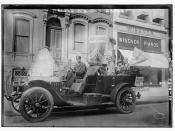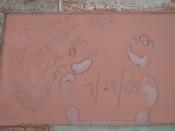Breaking conventions, breaking rules of filmmaking, breaking stereotypes:Endless SummerÃÂIt is worth reiterating that surfing films are not documentaries in the traditional sense of the mode. That is, they are not sober and objective narratives. The film therefore is meant to ÃÂstokeÃÂ the audienceÃÂ (Ormrod, 47). In 1962 Bruce Brown set out break the traditional sense of a surfing documentary and create one of the most important and influential films on extreme sports photography known as Endless Summer. With $50,000 that he borrowed, a Bolex 16mm camera, and two surfers, he single handedly produced, directed, filmed, and edited the most revolutionary sports documentary of all time. The film broke all preconceived notions about surf filmmaking and documentary filmmaking in general. It went from being a small surf project shown in high school auditoriums to spreading worldwide and taking in over $50 million. According to Vincent Canby of the New York Times, ÃÂIt may be one of the most successful documentary features ever made.ÃÂ
Bruce BrownÃÂs surfing legacy began as a stoked teenager in Long Beach, California. He developed a wholehearted love of the sport and always dreamed of conveying its true ideology to the rest of America. At the time, most of America stereotyped surfing as a lazy beach bum sport and as a waste of time. These times were also marked by the USÃÂs involvement in war with Korea. This lead to Brown being drafted into the Navy. He graduated sub-school at the top of his class and was granted the choice of which vessel to work on. Brown chose a submarine based in Honolulu Hawaii, where the waves were always good and he could surf every day. Brown surfed as much as he could and eventually developed an interest in surf film on an 8mm camera. He created a series of short surf flicks set to no audio and showed them in nearby auditoriums while providing live narration.
After finishing in the Navy, Brown moved back to California and began showing his short surf flicks around there. A man named Velzy saw great potential in BrownÃÂs surf flicks. At the time, there was absolutely no competition in the surf film business and Velzy saw this as an opportunity to create the first real surf film. He suited Brown up with a newly released Bolex 16mm reflex camera and $5,000 to go out and make a real 16mm movie about surfing. Brown was ecstatic and this funding began his filmmaking career as het set out to create a series of surf films. He would film for a couple months, create a surf film, screen it auditoriums charging admission and then use that money to fund the next. He said, ÃÂIÃÂd make $50 to $100 for each showing and sometimes IÃÂd do two or three in a day so that was pretty good money back thenÃÂ (Holmes, 61). Eventually, Brown realized that he might be able to make a decent living from his self-taught film skills. He continued to make the typical surf film, which consisted of a montage of surfing footage set over music.
By 1962, Brown was ready to break the typical surf film style and create something revolutionary. Brown said, ÃÂhe intended just to break away from the formula of the day-segments of hot-dogging in California and big-wave riding in Hawaii-and expand the surf film horizonÃÂ (Holmes, 61). Brown wanted to display to the American public what surfing was really about by producing a true documentary on surfing. ÃÂNot beach bums or playboys who sang to their girlfriends, but surfers who were athletes who enjoyed the adventure of scanning the globe in search of the perfect waveÃÂ (Ormrod 1). He wanted to break the negative stereotypes as being a lazy manÃÂs sport and show people the real emotion behind riding a wave. To do this, Brown needed to entice all audiences and not just the surfer world. Previously, fellow surfers were the only ones that could appreciate the action on screen because they understood it. Brown decided to break through to all audiences and capture their attention by giving this film a story and direction. He stated, ÃÂI think by integrating surfing with a story or some kind of themeÃÂ makes it suddenly entertainingÃÂ (Lisanti 277). This story or theme developed into an adventure in search of the perfect wave and to experience an endless summer by staying below the equator. The epic film, Endless Summer, is now underway.
Initially, Brown planned to travel to South Africa with a group of surfers and search around for unknown waves as they went. Brown stated, ÃÂOriginally we were just going to South Africa and then come backÃÂ But it turned out to be $50 cheaper to go all the way round the world, so we did thatÃÂ (Ormrod 1). BrownÃÂs plan now turned into a full out exploration of never-surfed waves around the world. Brown borrowed $50,000 in his own name to fund this new film. He then started planning with travel agents and designed a three-month trip to remote destinations such as Australia, New Zealand, South Africa, Tahiti, Ghana, Malibu, and Hawaii. For the film, Brown selected two surfers as his subjects; Mike Hynson and Robert August.
Finding locations for this documentary was no easy task. It wasnÃÂt like other documentaries where a producer could research a subject and locate a suitable location to portray it. This was an open frontier of never surfed waves in unknown locations. Brown, Hynson, and August had no idea where to look. Brown poured over maps, charts, and weather patterns, trying to figure out where in Africa there might be undiscovered surf based on his experience of where waves tended to be in the US. ÃÂIn these places where the natives had never heard of the sport of surfing, Brown had to rely on the knowledge of the fishermen to find beaches conducive to surfingÃÂ (Lisanti 276). Also, the budget put them on a time restraint because of having to pay for hotels and food, and so sometimes ÃÂwe only had a very short time to do what we wanted to do,ÃÂ said Brown. ÃÂIn Senegal, for example, we were only there for one or two days. There was no information. From looking at a map you could maybe figure out where there might be waves, but we didnÃÂt really explore the area so we had no idea if the days we were at some beach was a big day, a small day, a good swell or whateverÃÂ (Holmes 61). Some locations were chosen based on expectations or knowledge from locals, while others were just a pure gamble. Just this sheer difficulty of finding shooting locations set Endless Summer apart from previous documentaries of the time.
With one suitcase each and three surfboards, the two surfers and one amateur filmmaker set off to Senegal, western Africa to begin their 35,000-mile journey. They started finding waves right off the coast from the hotels at which they stayed. Locals were mesmerized by their surfing and often tried to imitate them with their fishing canoes. After they headed to Nigeria, where the water was an unheard of temperature of 91 degrees and the air temperature was well over 100 degrees. They continued traveling country to country searching the coasts and gathering unprecedented surfing footage. Lisanti writes, ÃÂThey crossed the equator five times and traveled to such exotic ports as Africa, New Zealand, Australia, Japan, Tahiti, and HawaiiÃÂ (276). After traveling for months and exploring through the desert of Cape Town, they came across a break at Cape St. Francis where ÃÂperfect cylinders peeled down a long, boulder-strewn pointÃÂ (Holmes 62). Here, the three surfers found waves that rode for over two minutes straight. As stated in OrmrodÃÂs text, ÃÂThis wave is so long and perfect that the surfers get cramps in their legs from squatting down in the curl. Brown concludes, ÃÂI couldnÃÂt help but think of the hundreds of years these waves mustÃÂve been breaking here but until this day no one had ever ridden oneÃÂÃÂ (Ormrod 47). Brown was not even able to catch an entire ride in one shot because the roll of film in the camera was not long enough. Here, Brown, August, and Hynson had discovered the perfect wave and accomplished their objective.
The nature of this film promoted Brown into coming up with many technical innovations. To get footage surfing from the actual board, ÃÂBrown designed a wind-up 16mm Bolex, which he described as being ÃÂthe smallest underwater housing in the world. ItÃÂs a very small, waterproof camera that only holds 50 feet of film and you have to spend most of your time reloadingÃÂ (Lisanti 276). Also, the distance between the beach and the surf sometimes proved to be too far, so Brown came up with ways to zoom in close enough. Holmes described his ingenuity with, ÃÂBrown went on to become an ingenious technical innovator, grafting big telephoto lenses onto tiny home movie cameras (and learning how to pan with them and get the exposures rightÃÂ (Holme, 61). Any cinematographer can understand that this is no easy task. People were always telling Brown that it wasnÃÂt possible with the currently technology, but he always seemed to find a way around it.
Brown eventually finished the film and returned to the US to show his work. No distributor wanted to pick it up, so he just began screening it in various areas around the country. He often screened it in high school auditoriums with an entrance fee while providing his own live narration. At the time, surf film economics did not stretch far enough to make sound prints, so Brown had to talk into a microphone while the film played to keep the audience informed and entertained. This misfortune of not being able to have sync sound was probably the most beneficial aspect to lending creativity into Endless Summer. He stated:If you get to a place where you think the audience is dragging you think, ÃÂwow, IÃÂd better think of something funny to say.ÃÂ IÃÂd ask some questions abut the name of the principal or the most hated teacher and then when there was a sequence of some horrible wipeout at pipeline or Waimea IÃÂd say, ÃÂAnd there he is, Mr. Johnson, going over the falls. Ouch thatÃÂs gottahurt!ÃÂ That kind of thing would always get a good laugh. (Holmes 59)Brown was constantly creating and recreating the narration to his documentary as he screened it at countless auditoriums, which eventually helped him develop an ideal narration track. Brown described this with, ÃÂwhen your editing you have the narration pretty much figured out, but then when you actually do it live you find out what works ad what doesnÃÂt work. But when you get a good reaction to a line, you donÃÂt forget it and it becomes part of the dealÃÂ (Holmes 59). Brown screened his film with live narration so many times, that eventually he was able to develop the perfect narration track for the final print.
These constant screenings of the film also helped market it by getting buzz going around the area for it. People would see it and tell others about how different it was, which lead to more people seeing it. To further promote it, Brown printed up posters and flyers about the screenings. In June 1964, Brown finally made an official release at the Santa Monica Civic Auditorium with a final narration track and a music track by the Sandals. The 3000-seat auditorium was sold out for a week. After the release, Brown teamed up with Hobie surfboards, a surfboard company out of California, and embarked to the east coast to further spread the film around the country. Brown exclaimed:Hobie had this big old motor home, so Hobie and his wife, Pat, and I, CorkyÃÂ we all piled into this thing and went across country, complaining to Hobie the whole time and then going to all his dealers down the east coast and making shows along the way. It was so popular that we began to think this thing could show in theaters all over the country, although of course nothing like that had been done before with a surf movie. (Holmes62)Brown and his team continued road tripping up and down the east coast further promoting their film while also seeking a deal that may bring it into mainstream distribution.
Brown knew nothing about distributing films initially and figured he might as well learn it first-hand. He went to distributors in New York in search of a deal, but no one accepted because they did not think anyone would want to watch it. They thought it was too different and did not fit into what people wanted to see. They stated that ÃÂit wouldnÃÂt draw an audience 10 miles from the oceanÃÂ (Lisanti 277). Brown started to think that maybe the distributors were right, but decided to find out for himself. He booked a showing in Wichita, Kansas in 1965 during the dead of winter when the temperature was 20 degrees. There happened to be a massive blizzard on the week that the film screened and locals were drawn to the theaters in search of an escape from the frigid weather. Beach scenes and warm weather climate in Endless Summer were just what the landlocked locals needed. The screening sold out for a week and was kept for an additional week because of its success.
Brown and his team thought they had it now, but the distributors were still unmoved. Browne remarked, ÃÂ Hollywood executives felt that since there was no sex and violence, it was therefore noncommercialÃÂ (Lisanti 277). Brown still felt instinctually that his film could be a success so he borrowed an additional $50,000 which brought his costs up to $100,000 now and used that money to blow it up to 35mm and have it screened in KipÃÂs bay theater in New York. It showed for a couple weeks and sold out the house, but Brown never received a call from a distributor. Finally, after receiving great reviews, on the films third week, it broke its opening record and distributors began calling Brown. He secured a distributor with Cinema V and the movie began setting attendance records across major cities. According to Entertainment weekly, ÃÂThe film was a phenomenal success and grossed $5 million in the U.S.ÃÂ Studio executives were stunned when they saw that it received national distribution and became a worldwide box office hit.
Endless Summer did more then just break preconceived notions about a surf film, it made the most important and influential statement on surfing; truth. During the 1960ÃÂs, the youth was greatly misrepresented by mass media as being portrayed what society expected of them. ÃÂThe Beach Boys particularly were marketed as all-American high school boys who surfed, were clean-cut, and cared only for cars, girls and fun, fun, funÃÂ (Ormrod 39). This was a fantasized portrayal of surfing and didnÃÂt convey what the sport was really about. It was exploited by pop culture in order to promote sales. People saw surfing as just a cool image and not really as a noteworthy cause. The creation of Endless Summer informed people about the actual lifestyle of surfing and why people go to such ends for a simple ride. Brown said, ÃÂThatÃÂs what IÃÂm proud of, because back then kids were being told to give up that stupid sport, that only beach bums surfed, that kind of thingÃÂ (Holmes 65). Endless Summer changed societyÃÂs perceptions of surfing and surfers and changed the way surfers saw themselves, which brought the sport to an all-time high.
Endless Summer broke all preconceived notions to what a sports documentary especially surfing could do. Filming in the unknown wilderness, using homemade camera innovations, self teaching filmmaking skills, live narrating in auditoriums, self marketing, finding distribution singlehandedly, and changing cultural beliefs on a sport are some of the many innovations that Endless Summer brought to documentary filmmaking. The film is really a work of pure ingenuity and following ones own instincts. Coming from just $50,000 and grossing over $50 million, changing the sport of surfing, and overcoming incredible odds, Endless Summer is by far and away the most successful surf documentary of all-time.
Works CitedBrown, Bruce. Endless Summer. 1966. DVD. Colombia.
Holmes, Paul. ÃÂIn Trim: Bruce BrownÃÂs Endless Epic.ÃÂ Longboard Magazine Dec. 2006: 54 - 65.
Lisanti, Thomas. ÃÂThe Endless Summer (1966).ÃÂ Hollywood Surf and Beach Movies. Jefferson: Mcfarland & Company, Inc., 2002.
Ormrod, Joan. ÃÂEndless Summer (1964): Consuming Waves and Surfing the Frontier.ÃÂ Film & History 35.1: 39-51. Ebsco Host. 24 Feb. 2009 .
![[Portrait of Juan Tizol(?) and Lawrence Brown(?), Aquarium, New York, N.Y., ca. Nov. 1946] (LOC)](https://s.writework.com/uploads/7/77189/portrait-juan-tizol-and-lawrence-brown-aquarium-new-york-n-thumb.jpg)




